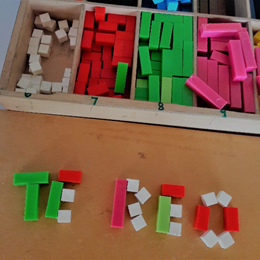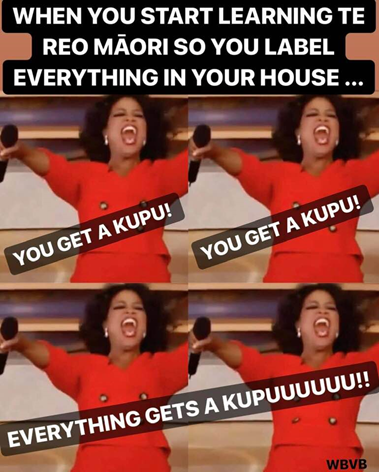Ph: 06 280 0938
Bettina Anderson: Toddling in Te Reo Māori

He Pākehā ahau!
Ko Bettina ahau. He Pākehā ahau.
Kāore tāku pepehā Māori ahau.
Nō te Tihi-O-Maru ki Te Waipounamu ahau.
Ko Kai Tahu te iwi o te wāhi i tipu ai ahau.
Kei Pōhangina ahau e noho ana.
Ko Rangitāne te iwi o te wāhi e noho ana.
Ko Anderson tōku ingoa whānau.
Nō Kōtirana ōku tūpuna.
I’m on a hīkoi (journey) to learn a language that is not my own, but I feel drawn to.
As a Pākehā growing up in Te Tihi-O-Maru in Te Waipounamu (Timaru in the South Island) in the 70 and 80s, the opportunities to learn the reo and rub up against Māori culture seemed few and far between. I went to an all-girls public school that might have had one or two Māori students if I remember rightly – certainly none in my year. I can recall taking a te reo elective on Fridays in the 4th form and that was the sum total of my exposure to the language (other than the odd road sign) throughout my high school and Uni years (I did a science degree). This was another time and place.
In the mid-90s, I cut my teeth in the workforce at an environmental engineering consultancy in Ōtautahi (Christchurch). Despite the fact that the RMA had passed into law in 1991, I cannot remember any occasions where the founding culture of this land was something I dealt with – maybe because I was such a junior kaimahi (worker)?
I moved to Te Papaioea (Palmerston North) in 1996 to work at Massey University and can vividly remember seeing the word “Aokautere” (a suburb in Palmy) on an AA sign for the first time and having absolutely no idea how to say it. Ouch! A large helping of shame gets served up with that memory…
Today, my kaiako (teacher) would probably say I still can’t pronounce Aokautere properly, but at least I am not afraid of that word anymore!
First Steps
During a second stint with an environmental consultancy in the early 2000s, the office manager and I took ourselves off to a basic te reo night class at the local kura tuarua (high school) to get our tongues around some reo pronunciation. We, like so many who have gone before when trying to learn kupu hou (new words), labelled everything in the office (and home) with sticky post-it notes – the fax machine was “waea whakaahua” the microwave “umu tira”…the meme below spotted recently on Pukamata (Facebook) reminding me of this.

Fast forward a few years and I switched careers to work in our local museum. Here my on-the-job education in the reo really began. I was working with Māori staff – whose job was to share their world and uphold their culture through the medium of exhibitions and artefacts. I attended pōhiri, went on marae stays, worked on preparing bi-lingual exhibitions and for the first time in my life, learnt about the importance of tohutō (macrons).
Macrons. In the early days of my museum career (before digital design apps carried the capacity to add these), they had to be drawn onto exhibition labels by hand. This little dash above a vowel, whose placement is critical to meaning and pronunciation, broke many a web and exhibition designer’s back in the day. Keke or kēkē? Cake or armpit? The difference comes down to macrons. Now many google fonts have them inbuilt and there’s a Māori keyboard you can install on your device that allows you to add macrons with a simple keystroke. You can even add them into texts (just don’t ask me how). Ka rawe (awesome)!
Putting one foot in front of the other
Last year I decided that I could do more. I’m a word wrangler and I wanted to be able to write in te reo and speak it too. I doggedly spent my evenings working my way through two online (and totally free!) courses at Te Wānanga o Raukawa in Ōtaki.
Aue! I only just managed to complete the second one, my problem being a common one for many Pākehā learners – the lack of anyone to practice my kōrero on. My comprehension had improved, but not my ability to string sentences together.
This year I decided I needed to study locally, old school, kanohi ki te kanohi (face to face) and I’m now several months into a full immersion class at Te Wananga o Aotearoa (also free!). I am scared witless every.single.minute of these classes. As a ‘professional learner’ (or so I thought), I‘ve had to unlearn my well-honed way of learning that has got me this far in life. No taking or referring to notes in class, no reading pre-written content (I’m a writer for god’s sake – how can I not do this!), no filling in the blanks in a workbook. It’s listen, watch, listen, speak, listen some more, speak some more. Make an epic twat of yourself in front of your classmates and your kaiako. Repeat.
Just in case you have the wrong idea here, I am officially a member of the really awkward reo club, a total te reo toddler (journalist Joel Maxwell coined this term in his insightful article on his own immersion learning journey). It’s epically hard but outstandingly rewarding and I’m loving it.
Sure, I am learning a language but it’s so much more that. I’m learning a way of learning, a way of being with people who are not like you but are at heart, a way of using language like I have never used it before – to welcome, to comfort, to share our human experience and connect us with land, people and place. I am the only Pākehā in my class but I am made so welcome, despite my stutterings and utterings that I can only imagine must make the kaiako and native speakers cringe (but they never show it). I feel privileged to be on this journey and I am so looking forward to where it will take me.
So why not join me in my awkward reo club? I really wish I had started earlier, and if you want to start steering your waka reo upstream and start paddling, here’s a few things I found useful (in rough order of effort required).
Getting started – some useful te reo Māori resources
- Challenge yourself to see what you know already with the 100 te reo words all NZ’ers should know quiz
- Sign up to “Kupu o te Rā” (Word of the Day) and get a new word sent to your inbox every day
- For a bit of fun try downloading the ‘take a picture and it’ll tell you the Māori word’ Kupu app available for free from the Google Play Store and the iOS App Store
- Bookmark the incredible online Maori Dictionary on your browser (or download the app) and check each time you use a Māori word that you have spelt and said it correctly
- Sign up to some reo groups on Facebook – I’m a fan of this one “Te Reo Māori O Aotearoa with Whaea Tarnz”
- Learn some simple te reo phrases/slang when you’re driving with Guyon Espiner from RNZ in these short (c.6 minute) podcasts
- Learn a bit more reo when you’re stuck in traffic with this under 15 minute podcast series by Scotty Morrison (his books are great too)
- Do an online course – the first one I tried and enjoyed was the free, online certificate called Poupou Huia Te Reo
- Learn with new friends and try a contact course – check out your local Wānanga – Te Wānanga o Aotearoa has many campuses around the country
Hōea tō waka! (Go for it!)
Nō reira, tēnā koutou, tēnā koutou, tēnā koutou katoa.
Collective Intelligence 2022 ©